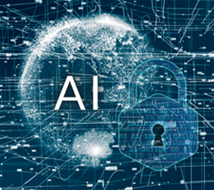By Diana Hennel, SVP, Chief Technology Officer
 October is Cybersecurity Awareness Month (CAM), a timely reminder of the ever-present online security threats financial institutions across the nation, and the world, must navigate. Fortunately, as cybersecurity tactics continue to evolve, emerging technology, such as Artificial Intelligence (AI), present new methods of effectively combatting them.
October is Cybersecurity Awareness Month (CAM), a timely reminder of the ever-present online security threats financial institutions across the nation, and the world, must navigate. Fortunately, as cybersecurity tactics continue to evolve, emerging technology, such as Artificial Intelligence (AI), present new methods of effectively combatting them.
AI is revolutionizing cybersecurity, bringing both significant advancements and new challenges. On the positive side, AI has greatly enhanced our ability to detect and respond to cyber threats. Conversely, cybersecurity criminals are also leveraging their capabilities to develop highly advanced attacks, putting sensitive data, and organizations that process it, at even greater risk.
The Influence of AI in cybersecurity
AI-powered tools can analyze vast amounts of data in real-time, identifying patterns and anomalies that may indicate a cyber-attack. This allows for quicker detection and response, potentially stopping attacks before they cause significant damage. For instance, AI can help in identifying and neutralizing phishing emails, which have become increasingly sophisticated and harder to detect with traditional methods.
Capabilities and challenges
Moreover, AI can improve the overall security posture of organizations by automating routine tasks, such as patch management and vulnerability assessments. This not only reduces the workload on cybersecurity professionals but also ensures that these critical tasks are performed consistently and accurately. AI's ability to learn and adapt over time means that it can continuously improve its detection and response capabilities, staying ahead of evolving threats.
However, AI also presents new challenges for cybersecurity. Cybercriminals are leveraging AI to develop more advanced and targeted attacks. For example, AI can be used to create highly convincing phishing emails that are tailored to individual victims, making them more likely to fall for the scam. Additionally, AI can be used to automate attacks, allowing cybercriminals to launch large-scale campaigns of malware and bots with minimal effort. AI generative malware can evolve to reestablish control when defenders deploy countermeasures.
AI can be used to quickly generate malware code that can attack known vulnerabilities as soon as they are released, and bypass user security controls. In addition, it is increasingly being used to generate deep fakes to effectively impersonate key personnel, including C-level executives.
Ransomware is also becoming increasingly cloud-aware as more companies host sensitive data in cloud environments. Cloud services, while not inherently more vulnerable to zero-day vulnerabilities, can be more attractive targets for attackers due to the large amounts of sensitive data they store and their accessibility from anywhere with an internet connection.
Open-source software, often used in cloud environments for its flexibility and customizability, typically lacks dedicated ongoing support, meaning vulnerabilities, while easy to identify, take much longer to mitigate.
Leveraging AI at Catalyst
Catalyst is actively addressing these challenges by leveraging AI to enhance its cybersecurity measures. Additionally, Catalyst is focusing on proactive behavior in digital privacy and security best practices, encouraging a culture of cybersecurity awareness among its stakeholders. Catalyst knows that protecting member and client data and providing seamless access to top tier services is at the heart of what we do.
While AI offers powerful tools to enhance cybersecurity, it also introduces new risks that must be carefully managed. Financial institutions need to adopt a balanced approach, leveraging AI's strengths while remaining vigilant against its potential misuse – not only during CAM, but every day as well.